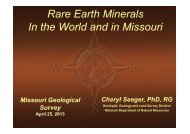You also want an ePaper? Increase the reach of your titles
YUMPU automatically turns print PDFs into web optimized ePapers that Google loves.
<strong>in</strong>teraction between oxidized groundwater and<br />
reduced geologic environments. Such deposits are<br />
known sources of uranium (e.g., Smith Ranch<br />
m<strong>in</strong>e, Wyom<strong>in</strong>g) and a silver and copper (e.g.,<br />
Paoli deposit <strong>in</strong> Oklahoma; Thomas and others,<br />
1991). These geological environments potentially<br />
host other metals as well.<br />
deacon’s Prayer Group claims, sE¼sE¼<br />
sec. 18, t. 32 n., r. 82 W., southern<br />
natrona county<br />
Griff<strong>in</strong> and Milton (1982) reported 90 ppm<br />
cU 3 O 8 , 250 ppm lanthanum, 70 ppm yttrium,<br />
3,000 ppm titanium, and 300 ppm zirconium<br />
with<strong>in</strong> a coarse-gra<strong>in</strong>ed to conglomeratic arkosic<br />
sandstone <strong>in</strong> the basal W<strong>in</strong>d River Formation. The<br />
area sampled by Griff<strong>in</strong> and Milton (1982) is located<br />
on private land, but the W<strong>in</strong>d River Formation<br />
crops out on adjacent public land to the north<br />
(Hunter and others, 2005).<br />
An arkosic, coarse-gra<strong>in</strong>ed sandstone <strong>in</strong>terbedded<br />
with a cobble- to boulder-conglomerate supported<br />
by a coarse gra<strong>in</strong>ed arkosic matrix crops out here<br />
on a ridge top that trends about 320˚. Clasts <strong>in</strong> the<br />
conglomerate are dom<strong>in</strong>antly felsic igneous rocks<br />
but mafic, metamorphic, and sedimentary clasts<br />
are also present. The sandstone hosts large iron<br />
concretions greater than 2 m (6 ft) across (table<br />
18). R<strong>in</strong>ds on the concretions, 10 to 20 cm (4 to<br />
8 <strong>in</strong>) thick, are composed of dark brown to yellow,<br />
very coarse-gra<strong>in</strong>ed, subangular, limonite-cemented<br />
lithic arkose (Sample 20121031JC-C). The <strong>in</strong>sides<br />
of the concretions are tan to yellow, very coarsegra<strong>in</strong>ed,<br />
subangular, calcite cemented, limo-<br />
55<br />
nitic lithic arkose (Sample 20121031JC-D). The<br />
<strong>in</strong>teriors of the concretions are not significantly<br />
enriched <strong>in</strong> any of the REE or any other <strong>elements</strong><br />
of economic <strong>in</strong>terest. However, the concretionary<br />
r<strong>in</strong>d (Sample 20121031JC-C) conta<strong>in</strong>s 152.2 ppm<br />
yttrium, greater than five times its crustal abundance,<br />
and is weakly enriched <strong>in</strong> all of the naturally<br />
occurr<strong>in</strong>g REE except europium and scandium<br />
(table 18). In addition, the r<strong>in</strong>d conta<strong>in</strong>s nearly 63<br />
ppm uranium and 0.094 percent titanium. When<br />
compared to the results of Griff<strong>in</strong> and Milton<br />
(1982), recent sampl<strong>in</strong>g <strong>in</strong>dicates that high concentrations<br />
of REE, yttrium, titanium, and uranium<br />
with<strong>in</strong> the Deacon’s Prayer claim group may be<br />
isolated occurrences.<br />
Phosphate-rich sedimentary<br />
occurrences<br />
Phosphatic shales and mudstones across Wyom<strong>in</strong>g<br />
are potential REE-hosts. Known REE occurrences<br />
are hosted by phosphatic shale and mudstone <strong>in</strong><br />
western and southwestern Wyom<strong>in</strong>g, and by phosphate<br />
concretions with<strong>in</strong> black shale <strong>in</strong> northern<br />
Wyom<strong>in</strong>g (fig. 21).<br />
uraniferous Phosphatic Horizons <strong>in</strong> the<br />
Wilk<strong>in</strong>s Peak Member of the Green river<br />
formation<br />
Love (1964) identified 32 uraniferous phosphatic<br />
horizons with<strong>in</strong> the Wilk<strong>in</strong>s Peak Member of the<br />
Green River Formation <strong>in</strong> the Green River Bas<strong>in</strong>.<br />
He also described <strong>in</strong> detail the lower 32.6 m<br />
(107 ft) of the Wilk<strong>in</strong>s Peak <strong>in</strong> a measured section<br />
on Lulu claim #2 that <strong>in</strong>cludes 13 lithologically<br />
table 18. Concentration of the REE, uranium, thorium, and titanium with<strong>in</strong> the W<strong>in</strong>d River Formation <strong>in</strong> the<br />
Deacon’s Prayer claim group. Bold values <strong>in</strong>dicate concentrations greater than five times crustal abundance.<br />
Element La (ppm) Ce (ppm) Pr (ppm)<br />
Deacon’s Prayer group<br />
Nd (ppm) Sm (ppm) Eu (ppm) Gd (ppm) Tb (ppm) Dy (ppm) Ho (ppm)<br />
20121031JC-C 66.1 111.5 13.8 48.1 11.25 1.82 19.35 3.03 18.8 4.11<br />
20121031JC-D 32.1 53.1 6.42 21.4 4.64 0.68 5.23 0.77 4.44 0.85<br />
Element Er (ppm) Tm (ppm) Yb (ppm) Lu (ppm) Sc (ppm) Y(ppm) Cumulative<br />
REE (ppm)<br />
U (ppm) Th (ppm) Ti (%)<br />
20121031JC-C 12.05 1.52 8.34 1.33 12.3 152.5 485.9 62.7 26.5 0.09<br />
20121031JC-D 2.43 0.32 1.91 0.3 7.9 26.2 168.7 35.5 14.6 0.08



